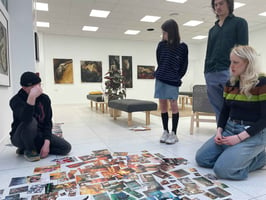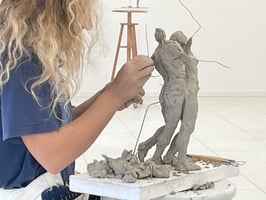Explore how individuals with Asperger’s Syndrome harness their unique perspective and abilities to...
Unveiling ASD and Artistic Creativity

Explore the unique intersection of Autism Spectrum Disorder (ASD) and artistic creativity, shedding light on how neurodiversity fuels innovation in the arts.
Diverse Cognitive Styles and Artistic Expression
The spectrum of cognitive styles within the Autism Spectrum Disorder (ASD) community is a vibrant tapestry of creativity, each thread weaving a unique and distinct artistic expression. From the meticulous attention to detail of some individuals to the expansive and abstract musings of others, the diversity in thought processes among those on the spectrum breathes life into their art. The artist with a penchant for minutiae crafts intricate and hyper-realistic drawings that captivate with their depth and complexity, while the abstract thinker challenges conventions, inviting viewers into a dialogue that transcends the visual realm.
The profound impact of these cognitive styles on artistic creation cannot be emphasized enough. The ability to delve deep into the minutiae allows for works of art that are rich in layers and intricacies, drawing the viewer in for a closer look. On the other hand, the visionary artist who sees the big picture without getting lost in the details produces art that is daring, original, and thematically expansive, pushing the boundaries of interpretation. Regardless of where they fall on the spectrum, each artist brings a unique perspective that enriches the artistic landscape, offering fresh insights and new ways of seeing the world.
Emotional Expression through Art for Individuals with ASD
Art serves as a transformative outlet for emotional expression, acting as a bridge between the inner world of individuals with Autism Spectrum Disorder (ASD) and the external realm. By channeling their emotions into various art forms such as painting, sculpture, music, or dance, individuals with ASD are able to communicate in ways that words often fail to capture. The process of creation becomes a form of catharsis, allowing for the release of pent-up feelings and thoughts that may otherwise remain hidden.
The resulting artworks are not merely visual representations but windows into the complex emotional landscapes of those with ASD. Each brushstroke, note, or movement conveys a depth of emotion that resonates with viewers, transcending language barriers and cultural differences. Through these artistic expressions, viewers gain a profound understanding of the inner workings of autistic individuals, fostering empathy, connection, and a greater appreciation for the unique emotional experiences of those on the spectrum.
In a world where verbal communication can be challenging for individuals with ASD, art becomes a universal language that speaks volumes without the need for words. It offers a glimpse into the rich inner world of autistic individuals, inviting others to see and feel the world through their eyes. Through art, emotions are translated into tangible forms, creating a shared space where understanding, empathy, and connection can flourish.
Innovative Problem Solving in Art by Autistic Creators
The innovative spirit of individuals with Autism Spectrum Disorder (ASD) shines brightly in the realm of artistic creation. Autistic creators possess a unique ability to approach challenges unconventionally, leading to the development of groundbreaking techniques and mediums in the arts. From experimenting with digital art to exploring avant-garde approaches in traditional practices like painting and sculpture, their ingenuity knows no bounds.
This innovative mindset not only elevates the individual's artistic practice but also propels the entire creative industry forward. By daring to push boundaries and question norms, autistic artists serve as trailblazers, inspiring new paths and possibilities in the artistic landscape. They embody the belief that limitations are merely springboards for creative problem-solving, showcasing the transformative power of thinking outside the box.
In a world that thrives on innovation and fresh perspectives, the contributions of autistic creators are invaluable. Their willingness to take risks, experiment, and challenge conventions not only enriches the arts but also paves the way for a more dynamic and inclusive artistic community. Through their pioneering spirit, autistic artists demonstrate that creativity knows no bounds and that diversity in thought is the catalyst for true artistic evolution.
The Impact of Routine and Repetition on Artistic Mastery
The dedication to repetition and the comfort found in routine not only serve as the foundation for achieving excellence in the arts for individuals with Autism Spectrum Disorder (ASD) but also unlock a pathway to artistic mastery. Embracing the disciplined practice required in disciplines like classical music, ballet, or printmaking, autistic artists harness their natural inclination towards repetitive patterns and structured environments to hone their skills to a level of expertise that is both technically proficient and deeply personal.
Through the commitment to perfecting their craft, autistic artists embark on a transformative journey of self-discovery and artistic growth. The repetitive nature of their practice becomes a meditative process, allowing them to delve deep into their art, uncovering new layers of creativity and expression with each repetition. This dedicated approach not only refines their technical abilities but also nurtures a profound connection between the artist and their chosen art form, resulting in works that resonate with authenticity and emotional depth.
As autistic artists immerse themselves in the rhythm of routine and repetition, they not only elevate their individual artistic practice but also contribute to the cultural landscape at large. Their unwavering dedication to mastering their craft showcases the heights of achievement that can be reached through disciplined effort, inspiring others to embrace the transformative power of repetition in their own creative pursuits. In this way, routine and repetition serve as pillars of artistic excellence, guiding autistic artists towards a deeper understanding of themselves and their art, while also enriching the artistic community with their unique perspectives and talents.
Advocacy and Awareness through Art in the Autism Community
Art transcends its aesthetic value when it becomes a powerful tool for advocacy and raising awareness about autism. Many talented autistic artists harness the transformative potential of their creative endeavors to challenge stereotypes, dismantle misconceptions, and champion neurodiversity. By infusing their art with personal narratives and lived experiences of ASD, these visionary creators invite viewers to step into their world, fostering empathy, understanding, and acceptance.
Through their thought-provoking exhibitions, captivating performances, and collaborative projects, autistic artists are not just making art; they are leading a movement that demands a reevaluation of the societal narrative surrounding autism. Their art serves as a beacon of empowerment for the autism community, amplifying their voices, sharing their stories, and advocating for inclusivity and equality. In a world where diversity is celebrated and differences are embraced, these artists stand at the forefront, demonstrating the profound impact of art as a catalyst for change and a vehicle for promoting a more compassionate and inclusive society.


